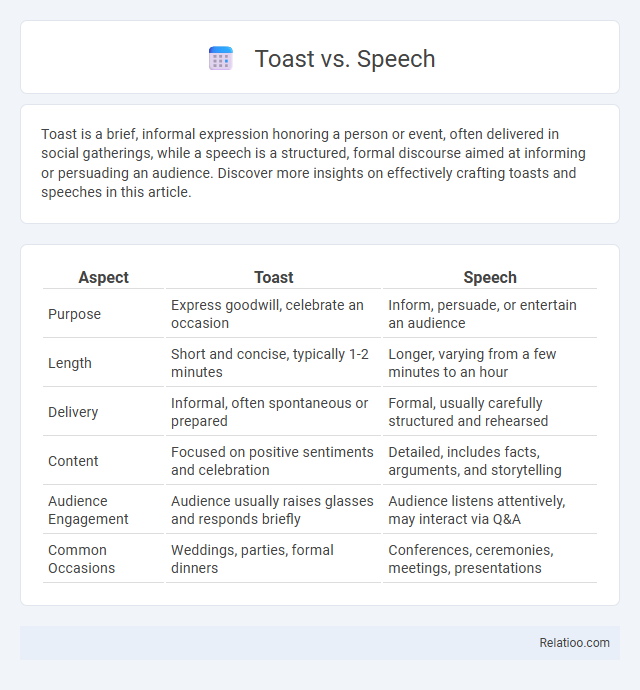Toast is a brief, informal expression honoring a person or event, often delivered in social gatherings, while a speech is a structured, formal discourse aimed at informing or persuading an audience. Discover more insights on effectively crafting toasts and speeches in this article.
Table of Comparison
| Aspect | Toast | Speech |
|---|---|---|
| Purpose | Express goodwill, celebrate an occasion | Inform, persuade, or entertain an audience |
| Length | Short and concise, typically 1-2 minutes | Longer, varying from a few minutes to an hour |
| Delivery | Informal, often spontaneous or prepared | Formal, usually carefully structured and rehearsed |
| Content | Focused on positive sentiments and celebration | Detailed, includes facts, arguments, and storytelling |
| Audience Engagement | Audience usually raises glasses and responds briefly | Audience listens attentively, may interact via Q&A |
| Common Occasions | Weddings, parties, formal dinners | Conferences, ceremonies, meetings, presentations |
Introduction: Understanding Toasts and Speeches
Toasts and speeches serve unique roles in social and formal events, with toasts typically being brief, celebratory statements and speeches providing a more structured, detailed address. You can use a toast to quickly honor a person or occasion with warmth and sentiment, while a speech often involves thorough preparation to convey messages, share stories, or inspire an audience. Understanding these differences helps you choose the appropriate approach to effectively communicate your message during special moments.
Purpose: When to Use a Toast vs. a Speech
A toast is a brief, celebratory expression of goodwill, often used to honor a person or occasion during social gatherings, while a speech involves a longer, structured presentation meant to inform, persuade, or entertain an audience. You should choose a toast when you want to create a moment of shared celebration and connection, typically in informal or ceremonial settings. A speech is more appropriate for delivering detailed information, conveying complex ideas, or addressing larger audiences at formal events.
Structure and Format Differences
Toast typically features a brief, informal structure with a clear opening, a few heartfelt points, and a concise closing, designed for celebratory occasions. Speech often follows a more formal format including an introduction, a detailed body with arguments or information, and a conclusion, suitable for diverse settings such as conferences or debates. Your choice between toast, speech, or toast depends on the event's tone and your desired level of formality and engagement.
Length and Duration Considerations
Toast messages typically display brief notifications lasting 2 to 3 seconds, designed for quick user feedback without interrupting interaction. Speeches vary widely in length, commonly ranging from a few minutes to over an hour, depending on context such as presentations, ceremonies, or keynotes. Compared to speeches, toasts generally last around 1 to 5 minutes, serving as concise, heartfelt acknowledgments or celebrations within social events.
Tone and Formality: Toasts vs. Speeches
Toasts typically feature a warm, conversational tone and are delivered in informal or semi-formal settings, emphasizing brevity and personal connection. Speeches maintain a more structured format with a formal or serious tone, aiming to inform or inspire a broader audience. While toasts create intimacy through humor and sentiment, speeches prioritize clarity and purpose to engage listeners effectively.
Audience Engagement Strategies
Toast leverages concise, heartfelt moments to create immediate emotional connections, while speeches utilize structured narratives to build deeper understanding and trust over time. Effective audience engagement in toasts often involves humor and relatability, whereas speeches benefit from storytelling techniques and clear calls to action. Both formats require adaptation to the audience's expectations and context to maximize impact and resonance.
Delivery Techniques: Toasts vs. Speeches
Toasts typically rely on brevity, personal anecdotes, and humor to engage listeners, making delivery more casual and intimate than speeches. Speeches demand clear articulation, structured arguments, and varied vocal tone to maintain audience interest and convey authority. Effective toast delivery often includes eye contact and pauses for laughter, while speeches benefit from formal body language and prepared notes to ensure clarity and impact.
Common Occasions for Toasts and Speeches
Common occasions for toasts include weddings, anniversaries, and formal dinners where short, celebratory messages honor individuals or milestones. Speeches are typically delivered at conferences, award ceremonies, and corporate events, offering detailed information, inspiration, or persuasion to an audience. Toast speeches combine elements of both, often occurring at social gatherings like birthday parties and retirement celebrations, emphasizing heartfelt appreciation in a concise format.
Dos and Don’ts for Each Format
When delivering a toast, keep it brief, positive, and personal, avoiding controversial topics and lengthy stories to maintain engagement. Speeches require clear structure, strong openings, and rehearsed content while steering clear of reading word-for-word or overloading with information. Your approach to a toast should be heartfelt and concise, contrasting with speeches that demand preparation and focus, ensuring your message resonates effectively in any format.
Conclusion: Choosing the Right Approach for Your Event
Selecting the right approach between a toast, speech, or toast speech depends on the event's formality, audience, and your comfort level with public speaking. Toasts are brief and celebratory, perfect for casual or intimate gatherings, while speeches offer a structured and detailed message suited for formal occasions. Your choice should align with the event's tone and your goal to effectively connect and engage your audience.

Infographic: Toast vs Speech
 relatioo.com
relatioo.com